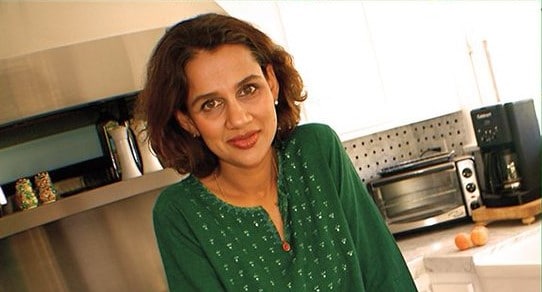Tired of Indian food being identified as “curry”, Indian-origin chef Kaumudi Marathe started the “first Indian cooking school” in the United States, called Un-curry. Marathe, who grew up all over the world, carries with her the perfect blend of different flavors mixed with the strong base of Indian cuisine. For her Indian food is her identity.
Marathe’s new book, Shared Tables: Family Stories and Recipes from Poona to LA, explores her roots in western India. She tells Little India about Indian cuisine, finding self in a foreign country and breaking the stereotypes about Indian food.
How did you realize that food is where your passion lay?
I have lived all over the world, from India to Wales, and then finally to the United States. As we traveled extensively and my mother cooked all kinds of food, I have tasted a range of cuisines all my life. It wasn’t until I got married that I felt the need to cook on a daily basis. I found it difficult to get a job as a journalist in the United States, so I thought of trying something that others couldn’t do. That’s how my journey to bring Indian food on the global platter began. I have always been keen on exploring the endless array of Indian recipes.
How do you think the food is connected to one’s identity?
I often felt caught between the East and the West, that I was neither Indian nor Western. Wherever I went I was a foreigner. So food was a way of exploring my identity, my heritage and my roots. Growing up in different parts of the world, with a mother who cooked internationally — homemade pizza one day, Sloppy Joes the next, or falafel and hummus, the third — I longed for a sense of history, of rootedness.
I got that when I visited my grandparents in Pune. My father’s mother made delicious harbhara karanjis with green peas that I still remember while my mother’s mother made fried pomfret, her santosh (tomato-coconut soup), and guava toffee, all of which I loved. But the one dish that inspired me was her garlic chutney, made silky-smooth on a paata-varvanta (horizontal grinding stone) in a way that no blender can achieve. That was the dish that gave me a desire to learn more about the history of my state’s cooking, its people and its culture, and to document it as I did in my cookbooks.
My family’s traditional recipes helped me connect to my roots not only because they resulted in delicious dishes but because they made me ask my grandmother questions about her marriage, in-laws, and life, all of which formed a backdrop to my own personal story.
Why the name Un-curry for your teaching school?
There is a myth in the Western world that Indian food revolves around “curry”. Many people think adding just the word “curry” at the end of the name of the dish would make it Indian. But many restaurants abroad lacked the essence of the country in their Indian dishes, which they termed “authentic”.
I wanted to make people aware that we don’t use the word “curry” in India and we have specific names for different food and it differs across the country. So when I started my catering food and cooking class, I decided to break the stereotype and named my company un-curry because Indian food is so much more than just a curry.
What do you love about Indian cuisine?
I don’t think there is any other culinary tradition that is as rich as Indian. And you can’t lump it as Indian food, you have to say Marathi cuisine, Bengali dishes or Malayali food. And yet the commonality between all these different traditions are the spices. I love the way we use the spices and how it is different from what everyone around the world does. For instance, nobody uses the spices for making the tadka.
What are the stereotypes that you have come across as a chef in the United States?
If you travel all around India, you won’t come across the same kind of food twice. Indian food is differentiated by region but also religion, caste and community.
Here, in the United States, people come into my classes assuming that they will learn how to cook chicken tikka masala and naan. They have no idea that India has a variety of bread and different types of curries.
The spices and the elaborate processes make Indian recipes look complex to foreigners. But when I show them how to do it, when they see the mustard seeds popping, there is an ‘Aha!’ moment that I find satisfying.
Many also feel that they Indian food is very heavy. But that’s not true for every Indian recipe. For instance, Marathi food has a lot of salads, which are very light. Indian food has a wide range of combinations, flavors and cooking methods, which are mostly unexplored abroad. Through my cooking class and my catering company I try to bring the world closer to the understanding of Indian recipes and India.
